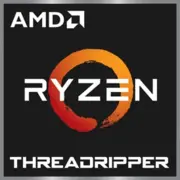AMD Ryzen Threadripper 1950

The AMD Ryzen Threadripper 1950 is a powerhouse of a processor that delivers exceptional performance for demanding tasks. With a total of 16 cores and 32 threads, this CPU is designed to handle intensive workloads with ease. The 32MB L3 cache ensures fast access to frequently used data, further enhancing its efficiency.
The 1950 features a 14nm Zen architecture, which provides a good balance between performance and power efficiency. With a TDP of 180W, this processor does require a robust cooling solution to operate at its best, but the power draw is well justified by the impressive performance it delivers.
The Threadripper 1950 is an excellent choice for content creators, gamers, and professionals who rely on their CPU for multitasking and heavy computational tasks. Whether you're editing 4K videos, running virtual machines, or compiling code, this processor can handle it all without breaking a sweat.
Overall, the AMD Ryzen Threadripper 1950 is a top-tier CPU that offers incredible multitasking performance and is a worthy investment for anyone in need of a high-performance desktop processor. Its powerful performance and multitasking capabilities make it an excellent choice for power users and professionals alike.
Basic
Label Name
AMD
Platform
Desktop
Model Name
?
The Intel processor number is just one of several factors - along with processor brand, system configurations, and system-level benchmarks - to be considered when choosing the right processor for your computing needs.
Ryzen Threadripper 1950
Code Name
Zen
Generation
Ryzen Threadripper (Zen (Whitehaven))
CPU Specifications
Total Cores
?
Cores is a hardware term that describes the number of independent central processing units in a single computing component (die or chip).
16
Total Threads
?
Where applicable, Intel® Hyper-Threading Technology is only available on Performance-cores.
32
Basic Frequency
3.2 GHz
Max Turbo Frequency
?
Max Turbo Frequency is the maximum single-core frequency at which the processor is capable of operating using Intel® Turbo Boost Technology and, if present, Intel® Turbo Boost Max Technology 3.0 and Intel® Thermal Velocity Boost. Frequency is typically measured in gigahertz (GHz), or billion cycles per second.
N/A
L1 Cache
96 KB (per core)
L2 Cache
512 KB (per core)
L3 Cache
32 MB
Multiplier Unlocked
Yes
CPU Socket
?
The socket is the component that provides the mechanical and electrical connections between the processor and motherboard.
AMD Socket SP3r2
Multiplier
32.0x
Bus Frequency
100 MHz
Technology
?
Lithography refers to the semiconductor technology used to manufacture an integrated circuit, and is reported in nanometer (nm), indicative of the size of features built on the semiconductor.
14 nm
TDP
180 W
Max. Operating Temperature
?
Junction Temperature is the maximum temperature allowed at the processor die.
68°C
PCI Express Version
?
PCI Express Revision is the supported version of the PCI Express standard. Peripheral Component Interconnect Express (or PCIe) is a high-speed serial computer expansion bus standard for attaching hardware devices to a computer. The different PCI Express versions support different data rates.
Gen 3, 60 Lanes (CPU only)
Transistors
9,600 million
Memory Specifications
Memory Type
?
Intel® processors come in four different types: Single Channel, Dual Channel, Triple Channel, and Flex Mode. Maximum supported memory speed may be lower when populating multiple DIMMs per channel on products that support multiple memory channels.
DDR4
Memory Channels
?
The number of memory channels refers to the bandwidth operation for real world application.
Quad-channel
ECC Memory
No
GPU Specifications
Integrated Graphics Model
?
An integrated GPU refers to the graphics core that is integrated into the CPU processor. Leveraging the processor's powerful computational capabilities and intelligent power efficiency management, it delivers outstanding graphics performance and a smooth application experience at a lower power consumption.
N/A
Share in social media
Or Link To Us
<a href="https://cputronic.com/cpu/amd-ryzen-threadripper-1950" target="_blank">AMD Ryzen Threadripper 1950</a>